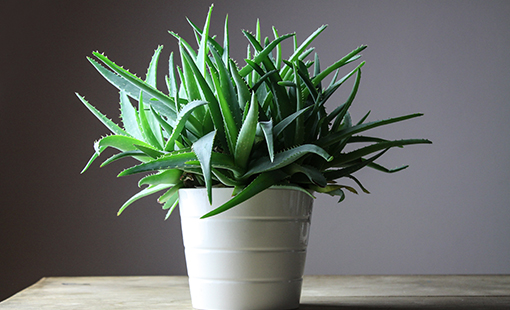
Growing and Using Aloe Vera
Aloe vera is commonly grown as a houseplant and gained favor because the gel from its leaves makes a soothing skin salve (although some people are actually irritated by the gel).
It has thick, succulent leaves that are plumped up with a watery gel. The leaves grow from the base of the plant, in a rosette and have jagged edges with flexible spines. It’s a fast-growing succulent, taking three to four years to reach a mature size.
The spiky flowers appear on tall stalks, in shades of yellow, red or orange. Young plants don’t usually flower, and aloe grown as a houseplant can take years to produce a flower stalk.
Care
Since aloe vera needs a sandy or gravelly soil, when grown outdoors it is best used with other succulents with similar needs. To blend aloe into a border planting, pot it separately and use as a focal point. Raising the pot to eye level will make it more prominent. Potted aloe grows well on decks and patios where it is handy for emergency burns and bites.
Blooming occurs in late spring/early summer. Plants need to be quite mature to begin blooming and may not bloom every year if the leaves are being harvested.
Light
Aloe vera needs to be in a place that’s bright with indirect sunlight. Direct sun can burn its tender skin.
Soil
Soil needs to be well-draining. In its natural habitat, aloe generally grows on slopes so that good drainage is guaranteed. To ensure drainage in a pot, you can use a special cactus potting soil or mix in some perlite or coarse sand and make your own mix.
Water
Aloe can handle drought well, but prefers to be watered regularly, allowing the soil to dry out completely between waterings. If the plant is left dry too long, the leaves will shrivel and pucker slightly. They will recover when watered, but prolonged stress, either too much drought or too much water, will cause the leaves to yellow and die.
Do not give the plants any supplemental water during the rainy season. Most aloes go dormant in the winter and won’t require any water at all, provided they received sufficient water during the growing season. If your climate is rainy during the winter, consider planting your aloe in gravel or stones. They will allow the water to run off.
Temperature and Humidity
Aloe vera does best between 55 and 85 degrees Fahrenheit, but will tolerate 40 degrees Fahrenheit. It cannot tolerate frost.
Fertilizer
Aloe vera does not require a high soil fertility. Feeding once a year, in the spring, with a houseplant fertilizer should be sufficient.
Pruning
If the outer leaves of your aloe vera plant get brown tips, it’s time for some pruning. Using clean garden shears, you can decide to simply cut off the affected area of the leaf, or prune the entire leaf altogether, close to the base of the plant. This will encourage new growth. Never prune leaves in the center.
Overwintering
Aloe vera cannot tolerate frost and if you live in a colder climate, it should be kept in containers and brought inside for the winter. If you’re experiencing an unexpected frost, cover aloe plants with sheets or blankets to keep them warm.
Common Pests & Diseases
Aloe vera attracts mealybugs, scales and mites. Wipe mealybugs away with a soft cloth, after spraying the plant with water. For scales, whip up a mixture of 1 tablespoon insecticidal soap and 1 cup isopropyl alcohol mixed with 1 cup of water; spray scales with this solution every three days for 14 days. For mites, prune out infected tissue to keep this plant, and your other aloes, safe from harm.
How to Use the Aloe Gel
Aloe in its purest form can be pureed with a fruit smoothie or juiced with other vegetables and fruit. It can also be cut into cubes and preserved by freezing for a month. The jury is still out in the scientific community as to the health benefits, but many users feel the plant is useful as a digestive health supplement. Either way, the live plant juices are a good nutritional supplement just as any leafy green, and the texture adds interest to juices.
In addition to harvesting aloe for its nutritional benefits, you can pick the leaves as needed for the treatment of minor burns or scrapes. Just squeeze the juicy sap onto the affected area for instant relief. If you are lucky enough to have large specimens, go out and harvest an aloe plant and see for yourself what the fuss is all about.
Information courtesy of TheSpruce.com and GardeningKnowHow.com

 Adams Fairacre Farms
Adams Fairacre Farms